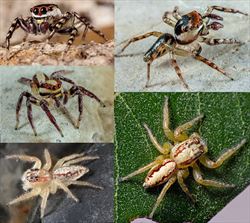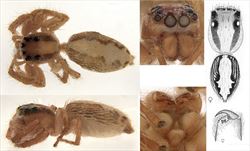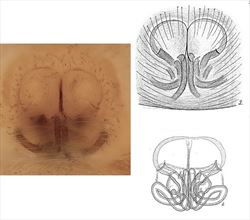
Examples of live Cytaea
Illustrator (and ©) I.R. Macaulay, R. Whyte (BR)

Aspects of the general morphology of Cytaea
Illustrators (and ©) B.J. Richardson (CSIRO), M. Zabka (diag.) (QMB)

Palp morphology of Cytaea
Illustrators (and ©) B.J. Richardson (L) (CSIRO), R. Whyte (M), M. Zabka (diag.))

Epigyne morphology of Cytaea
Illustrators (and ©) B.J. Richardson (CSIRO), M. Zabka (diag.) (QMB)
Cytaea Keyserling, 1882
Taxonomy
Cytaea, found in Australian, Pacific and Oriental Regions, has eleven Australian species: Cytaea alburna, C. barbatissima, C. clarovittata, C. frontaligera, C. mitellata, C. morrisoni, C. nigriventris, C. piscula, C. plumbeiventris, C. severa and C. sinuata. Some of these are shared with Papua New Guinea, various Pacific Islands, Indonesia, Singapore and Malaysia. There are many undescribed species in Australia. Past synonomisations of Cytaea expectans and Cytaea xanthopus with Cytaea plumbeiventris present some difficulties and may be subject to revision. Cytaea nimbata is known from Australia with many specimens recorded, Whyte and Anderson (2017). Further information on the genus and described species can be found in Richardson and Żabka (2017) and Whyte and Anderson (2017).
Description
Cytaea spp. are small to medium-sized spiders, ranging in body length from 3 to 9 mm. The cephalothorax is rounded, widest behind the posterior median lateral eyes. Some species are brightly coloured with colours changing between localities to match the substrate. The chelicerae have a bicuspid retromarginal tooth (fissident) and three or more teeth on the promargin. The abdomen is ovate to elongate-ovate. The legs are slender and do not differ greatly in length.
The male palp varies in structure. The embolus can be long and slender arising from the lateral or distal edge of a bulb making a half to several anticlockwise circles around the bulb, ending distally. Some species have more basic arrangements of the embolus. The tegulum is short and also varies in shape between species. The retro-lateral tibial apophysis is short and sharp with a slightly-hooked end.
The female has two epigynal atria with well sclerotised guides. The copulatory openings open on the posterior edges of the atria. The highly-coiled insemination ducts and spermathecae are located between and overlapping the margins of the atria, adjacent to the epigastric fold.
Biology
Cytaea is usually found on foliage but also occasionally under bark or rocks in habitats ranging from grasslands to rainforest.
Distribution
Cytaea is found across most of mainland Australia from semi-desert to the coast, north of Perth and Sydney. It is also found in southeast Asia and the south west Pacific.
References
Davies, V.T. & Żabka, M. 1989 Illustrated keys to the genera of jumping spiders (Araneae: Salticidae) in Australia. Memoirs of the Queensland Museum 27, 189-266.
Richardson, B.J. & Żabka, M. 2017. Salticidae. Arachnida: Araneomorphae. Canberra, Australian Faunal Directory. Australian Biological Resources Study, at https://biodiversity.org.au/afd/taxa/SALTICIDAE.
Whyte, R. & Anderson, G. 2017. A Field Guide to Spiders of Australia. CSIRO Publishing: Clayton.
* The information sheet should be interpreted in the context of the associated diagrams and photographs. Diagrams explaining anatomical terms can be found in the ‘Salticidae’ pictures at the beginning of the list of genera.